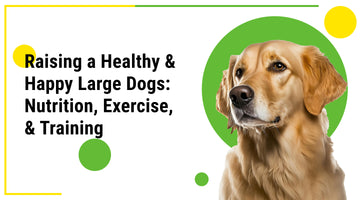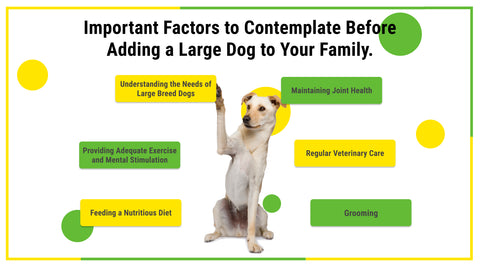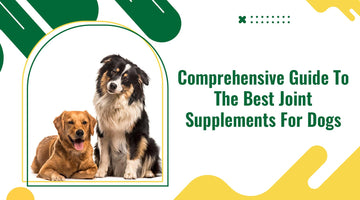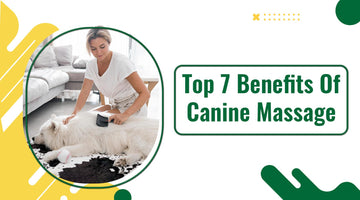Raising a Healthy & Happy Large Dogs: Nutrition, Exercise, & Training
by Curtis Greenwald on Mar 05, 2024

When bringing a furry friend into the family, contemplating the responsibilities of properly caring for a large breed dog is paramount. Big dogs have greater needs, ranging from nutrition to exercise to grooming and veterinary requirements.
Providing adequate care promotes your large pup’s health and happiness while strengthening your bond through respect and trust. This article covers key considerations for thriving with a gentle giant canine companion.

Important Factors to Contemplate Before Adding a Large Dog to Your Family
Understanding the Needs of Large Breed Dogs
Large and giant breeds like Great Danes, Mastiffs, Saint Bernards and Leonbergers have specific needs differing from smaller dogs. Their sheer size dictates greater food consumption to fuel an expansive body. Larger builds also commonly suffer joint issues under excessive weight, demanding thoughtful nutrition and mobility support. And abundant energy stores require sufficient activity outlets. Know these needs beforehand.
Providing Adequate Exercise and Mental Stimulation
With enhanced strength and endurance compared to toy breeds, large dogs require appropriately vigorous physical and mental exercise to stay fit and avoid destructive behaviors born of boredom. Aim for at least 60-90 minutes of daily activity through leashed walks, runs, playtime, and brain-engaging training. Interactive toys also supplement stimulation when you’re away.
Feeding a Nutritious Diet
The right diet fuels large breed health, longevity and injury resilience. Quality proteins build and preserve muscular mass while glucosamine and chondroitin support joint cartilage and treat arthritis. Omega fatty acids reduce inflammation, boosting mobility and heart health. Slow-burn carbs provide sustainable energy for an active lifestyle. Portion control maintains lean muscle over fat as well. Talk to your vet about recipe suggestions for your dog’s needs.
Maintaining Joint Health
Larger dogs’ considerable body mass and energetic exercising regimens take a toll on cruciate ligaments, hip and elbow joints over time. Supplements like Camelina Omega oil introduce omega-3s to lubricate joints and anti-inflammatory compounds to ease chronic arthritis and pain. Consult your veterinarian about integrating supplements with medications for optimal mobility as your big pup ages.
Derived from US-grown camelina seed, Camelina Omega underwent minimal processing maximizing omegas 3, 6 and 9 for robust canine joint, coat and immune support with no additives or fillers. Its rich antioxidant content also promotes longevity. The same oil nourishing horses and other livestock also works wonderfully for dogs. Talk to your vet about dosage based on weight, targeting anti-inflammatory benefits and enhanced flexibility.
Regular Veterinary Care
Given their genetic disposition for bone, joint and heart disease risks, frequent vet checkups enable early diagnosis and tailored treatment improving life expectancy. Annual visits tracking weight, diet, medication adjustments and behavior identify emerging issues. Senior large breed dogs benefit especially from biannual vet exams to maintain quality of life. Developing a relationship with the same vet also nurtures familiarity with your dog’s progression.
Grooming
Consistent grooming limits shedding and promotes circulation for big dogs with considerable fur. Weekly brushing followed by a bath every few months removes loose hair and dirt from the undercoat keeping your home clean. Trim overgrown fur obstructing eyes or paw pads as well. Careful nail clipping prevents painful cracks and scratches. Develop a regular routine.
In caring for a beloved big breed dog, prioritizing exercise outlets, healthy diet, joint support, veterinary relationships and grooming keeps your loyal companion thriving. Show them daily appreciation, and their heart and dedication fills your home with joy.
Conclusion
Welcoming a large dog breeds significant benefits like endless affection, home security, lively fun and unconditional companionship. But with bigger builds come greater caretaking duties as guardians. Committing to your dog’s unique needs cements a deeply rewarding bond built on trust and respect that lasts for years to come. Do your homework beforehand, chat with your vet and train consistently. Soon, your gentle giant becomes part of the family.
How Camelina Equine Omega Oil Can Help?
Integrating supplements like Camelina equine Omega Oil into their care regimen can provide additional support for joint health, coat maintenance, and immune system strength. Derived from high-quality camelina seeds and rich in omega-3, 6, and 9 fatty acids, Camelina Omega Oil offers robust benefits without any additives or fillers, promoting longevity and overall well-being for large breed dogs.
By approaching the care of large dogs with dedication, knowledge, and the incorporation of beneficial supplements like Camelina Omega Oil, pet parents can create a harmonious and joyful environment where their canine companions flourish and become cherished members of the family for years to come.
Frequently Asked Questions
How do you manage a large dog?
Consistently provide sufficient physical and mental stimulation. Feed a nutritious, portion-controlled diet. Support joint health with vet-approved supplements. Maintain thorough grooming routines and annual vet visits. Show firm leadership while being a trusted companion.
What do you class as a large dog?
While definitions vary between kennel clubs, dogs categorized as large breeds typically start around 50-60 lbs, reaching over 100 lbs for extra large varieties. Common large breeds include Labrador Retrievers, German Shepherds, Boxers and Siberian Huskies.
How do you get a big dog to respect you?
Establish pack leader status with confident, consistent verbal cues, training reinforcement and measured responses addressing problem behaviors. Ensure sufficient exercise outlets and stimulation. Reward respectful interactions with affection and motivate with incentive-based commands fostering trust.




